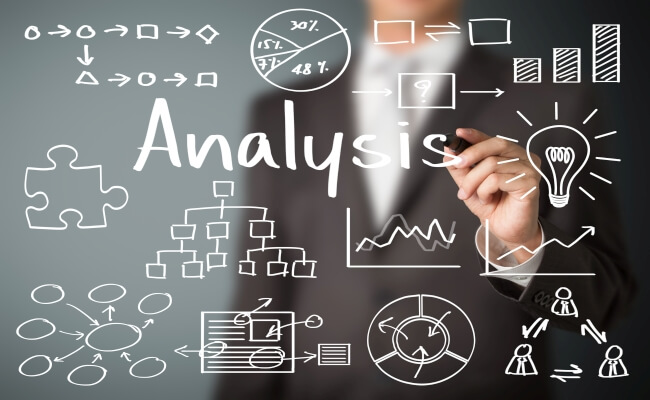Data Analysis and Data Interpretation are some of the most evolving trends in 2022 due to the importance of data in this digital age. Enterprises rely on data for all relevant decision making processes by methods of analyzing, preparing accurate reports and adapt to the changing business trends as and when needed. Big data analytics is a buzzword that most companies focus on. This is because it has the potential to share precise KPIs for any kind of data analysis (qualitative and quantitative). In order to proceed further, it is first extremely important to study data interpretation. So, let’s begin.
Data Interpretation: Decoding Data
The process of leveraging multiple types of analysis to study business critical data to make better decisions for a business is called data interpretation. Some of the most important answers in business can be found using accurate data and hence it is crucial to give enough importance to the study of data.

As we have seen above, data interpretation is essential for any business and hence it is important not to neglect data interpretation. There are multiple sources of data in a business and it is difficult to find the source as the data doesn’t come in an order. It is a subjective process and depending on the business requirement, data interpretation can be dived into two classes “qualitative and quantitative analysis”.
It is important to note that visual representation of data is of no use if the data interpretation is not done properly. There are four types of scales that are used to calculate the ROI from the process which are:
Nominal Scale – In this type of selection, variables are used and is typically used for non-numerical factors.
Ordinal Scale – Just like nominal scale, this is an exhaustive type of scale. For instance, the ordinal scale includes good, very good, excellent and more.
Interval – As the name suggests, in this type of segment data is segmented with equal distances between two sets.
Ratio – In this type of data segment, the above three types (nominal, ordinal, and interval) scales are used.
Now, as you decide one of the four types of scales to be used, the next important step is to choose the data interpretation method. Let us find out how.
How is Data Interpretation done?

For any kind of data analysis, it is essential to understand the distinction between correlation and coincidences. Moreover, it is important to go with a method that has the ability to produce results.
Data interpretation is used by enterprises to decode valuable information from large chunks of data that is collected in no particular order. The Data analysis team will prefer to have a structure for the analysis and reporting as different teams tend to use data differently and can have a varied approach for collection and interpretation of data. In the following section, we will look at both qualitative and quantitative data types.
Qualitative Data Interpretation
In this type of data interpretation method, data is not present in numerical values and is difficult to decode. Some of the methods in qualitative data interpretation include:
Focus groups – In this method, a group of people are gathered and asked a few questions related to the topic.
Observations – Firstly, an observation group is formed and their pattern is to be studied.
Secondary Research – In this process, multiple types of study material can be coded and dissected into different types.
Interviews – When it comes to qualitative data, interviews are an excellent way to study behavior and patterns.
One of the most significant difference between both qualitative and quantitative methods is the way data is interpreted. It is important to note that qualitative data has room for interpretation and is not just dependent on numerical values.
Recommended for you: Oracle Paas: How to Manage Software Applications in the Cloud?
Quantitative Data Interpretation
Quantitative data, in simple terms means the study of numerical data. It is quite different than qualitative data because in this type of data, there are a lot of numbers to be played around and no need of any qualitative research to come to conclusion. It is a collection of methods used by businesses to make informed decisions by analysis of data. Some of the most commonly used methods in quantitative analysis include mean, median and standard deviation. You must have studied these terms in school, but let us brush up these topics for better understanding.
Mean – In simple terms, a mean is the central value to a collection of data. For example, there are 5 values a, b, c, d, e and the median of these values would be calculated by adding a+b+c+d+e and dividing it by total number of values (5). It is a part of studies in Math and Mean is similar to arithmetic mean.
Std Deviation – Another commonly used method for quantitative analysis is standard deviation. It includes the quantitative distribution of collected responses around the mean. The standard deviation goes one step beyond Mean in order to provide a more quantitative response to the solution.
Frequency – The third and the last type of method is frequency distribution. It checks how frequent a response is featured in the collection of responses or data. For example, when working on a population control survey, frequency distribution is used to understand how many times a response is repeated in the data set.
By looking at both qualitative and quantitative data interpretation methods, it is safe to say that quantitative data method relies on numbers to prove a correlation between two points. Businesses can use one or more methods simultaneously in order to find the best possible response to their data collection and interpretation query.
Conclusion
In this post, we tried to cover all the critical aspects pertaining to data interpretation and how to interpret data effectively. We hope you have a better understanding of the topic. It is evident that data interpretation is extremely crucial. What is your current understanding of data interpretation? Would you like us to make another blog consisting of Data Interpretation problems and methods for better data analysis? Let us know in the comments below or write to us at [email protected].



